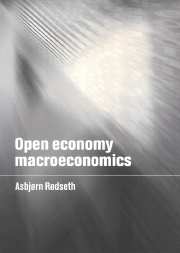Book contents
- Frontmatter
- Contents
- List of figures
- List of tables
- Preface
- List of standard symbols
- Introduction
- Part 1 Financial markets
- 1 The foreign exchange market
- 2 Portfolio choice, risk premia and capital mobility
- 3 Money
- 4 The monetary theory of the exchange rate
- Part 2 The open economy
- Part 3 Policy issues
- Appendixes
- Notes
- Bibliography
- Index
2 - Portfolio choice, risk premia and capital mobility
Published online by Cambridge University Press: 06 July 2010
- Frontmatter
- Contents
- List of figures
- List of tables
- Preface
- List of standard symbols
- Introduction
- Part 1 Financial markets
- 1 The foreign exchange market
- 2 Portfolio choice, risk premia and capital mobility
- 3 Money
- 4 The monetary theory of the exchange rate
- Part 2 The open economy
- Part 3 Policy issues
- Appendixes
- Notes
- Bibliography
- Index
Summary
In chapter 1 we postulated a demand function for foreign currency. In this chapter we derive foreign currency demand from maximizing behaviour and give a brief survey of empirical evidence. The choice of portfolio composition when rates of return are risky has been studied extensively in the theory of finance. In economics expected utility maximization is the dominating theory of choice under uncertainty. However, in finance, the general state-preference theory has given few useful results. A large part of the theory of finance therefore uses ‘mean–variance theory’, which is compatible with expected utility maximization only when special assumptions are satisfied.
In the first two sections of this chapter we apply mean–variance analysis. In section 2.1 we derive the demand functions for foreign currency, and in section 2.2 we go on to discuss market equilibrium. This approach is chosen because it is effective in demonstrating which factors must be important for currency demand. In section 2.3 the validity of the mean–variance model is discussed together with some possible extensions. In section 2.4 we give an example of how expected utility maximization can be applied to a case where mean–variance analysis may not be adequate. Section 2.5 contains a brief summary of some empirical research on capital mobility between currencies and the related issue of exchange rate expectations.
Capital mobility between currencies is just one aspect of capital mobility. The general issue is to what extent capital flows between countries and currencies respond to differences in expected returns.
- Type
- Chapter
- Information
- Open Economy Macroeconomics , pp. 40 - 62Publisher: Cambridge University PressPrint publication year: 2000



